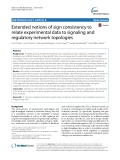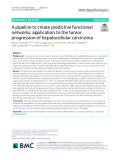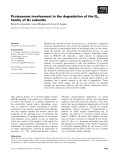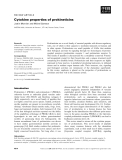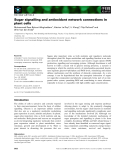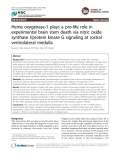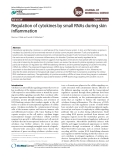
Signaling and regulatory knowledge
-
A rapidly growing amount of knowledge about signaling and gene regulatory networks is available in databases such as KEGG, Reactome, or RegulonDB. There is an increasing need to relate this knowledge to highthroughput data in order to (in)validate network topologies or to decide which interactions are present or inactive in a given cell type under a particular environmental condition.
 13p
13p  vioklahoma2711
vioklahoma2711
 19-11-2020
19-11-2020
 9
9
 0
0
 Download
Download
-
Integrating genome-wide gene expression patient profiles with regulatory knowledge is a challenging task because of the inherent heterogeneity, noise and incompleteness of biological data. From the computational side, several solvers for logic programs are able to perform extremely well in decision problems for combinatorial search domains.
 14p
14p  vicolorado2711
vicolorado2711
 23-10-2020
23-10-2020
 23
23
 1
1
 Download
Download
-
Insulin is the principal regulatory hormone involved in the tight regulation of fuel metabolism. In response to blood glucose levels, it is secreted by the b cells of the pancreas and exerts its effects by binding to cell surface receptors that are present on virtually all cell types and tissues. In humans, perturbations in insulin function and/or secretion lead to diabetes mellitus, a severe disorder primarily characterized by an inability to maintain blood glucose homeostasis. Furthermore, it is estimated that 90–95% of diabetic patients exhibit resistance to insulin action....
 10p
10p  research12
research12
 01-06-2013
01-06-2013
 33
33
 3
3
 Download
Download
-
Metabolically unstable proteins are involved in a multitude of regulatory networks, including those that control cell signaling, the cell cycle and in many responses to physiological stress. In the present study, we have deter-mined the stability and characterized the degradation process of some members of the Gq class of heterotrimeric G proteins. Pulse-chase experi-ments in HEK293 cells indicated a rapid turnover of endogenously expressed Gaq and overexpressed Gaq and Ga16 subunits.
 13p
13p  fptmusic
fptmusic
 12-04-2013
12-04-2013
 36
36
 1
1
 Download
Download
-
Accumulating evidence indicates that G protein signaling plays an active role in the regulation of cell survival. Our previous study demonstrated the regulatory effects of Gi⁄ o proteins in nerve growth factor-induced activa-tion of pro-survival Akt kinase. In the present study we explored the role of various members of the Gs,Gq⁄ 11 and G12⁄ 13 subfamilies in the regula-tion of Akt in cultured mammalian cells.
 11p
11p  inspiron33
inspiron33
 26-03-2013
26-03-2013
 43
43
 3
3
 Download
Download
-
This review discusses the talks presented at the third EMBL Biennial Sym-posium, From functional genomics to systems biology, held in Heidelberg, Germany, 14–17 October 2006. Current issues and trends in various sub-fields of functional genomics and systems biology are considered, including analysis of regulatory elements, signalling networks, transcription networks, protein–protein interaction networks, genetic interaction networks, medical applications of DNA microarrays, and metagenomics.
 10p
10p  galaxyss3
galaxyss3
 21-03-2013
21-03-2013
 39
39
 2
2
 Download
Download
-
Prokineticins are a novel family of secreted peptides with diverse regulatory roles, one of which is their capacity to modulate immunity in humans and in other species. Prokineticins are small peptides of 8 kDa that mediate their biological activities by signaling through two homologous G-protein-coupled receptors (prokineticin receptor 1 and prokineticin receptor 2).
 8p
8p  galaxyss3
galaxyss3
 07-03-2013
07-03-2013
 38
38
 2
2
 Download
Download
-
Sugars play important roles as both nutrients and regulatory molecules throughout plant life. Sugar metabolism and signalling function in an intri-cate network with numerous hormones and reactive oxygen species (ROS) production, signalling and scavenging systems.
 16p
16p  mobifone23
mobifone23
 21-01-2013
21-01-2013
 49
49
 3
3
 Download
Download
-
Cells respond to environmental cues through a complex and dynamic network of signaling pathways that normally maintain a critical balance between cellular proliferation, differentiation, senescence, and death. One current research challenge is to identify those aberrations in signal transduction that directly contribute to a loss of this division-limited equilibrium and the progression to malignant transformation. The study of cell-signaling molecules in this context is a central component of cancer research.
 349p
349p  spy107
spy107
 11-10-2012
11-10-2012
 51
51
 5
5
 Download
Download
-
Despite its clinical importance, a dearth of information exists on the cellular and molecular mechanisms that underpin brain stem death. A suitable neural substrate for mechanistic delineation on brain stem death resides in the rostral ventrolateral medulla (RVLM) because it is the origin of a life-and-death signal that sequentially increases (pro-life) and decreases (pro-death) to reflect the advancing central cardiovascular regulatory dysfunction during the progression towards brain stem death in critically ill patients.
 12p
12p  toshiba23
toshiba23
 18-11-2011
18-11-2011
 51
51
 1
1
 Download
Download
-
Abstract Intercellular signaling by cytokines is a vital feature of the innate immune system. In skin, an inflammatory response is mediated by cytokines and an entwined network of cellular communication between T-cells and epidermal keratinocytes. Dysregulated cytokine production, orchestrated by activated T-cells homing to the skin, is believed to be the main cause of psoriasis, a common inflammatory skin disorder.
 19p
19p  toshiba23
toshiba23
 18-11-2011
18-11-2011
 51
51
 2
2
 Download
Download
CHỦ ĐỀ BẠN MUỐN TÌM








